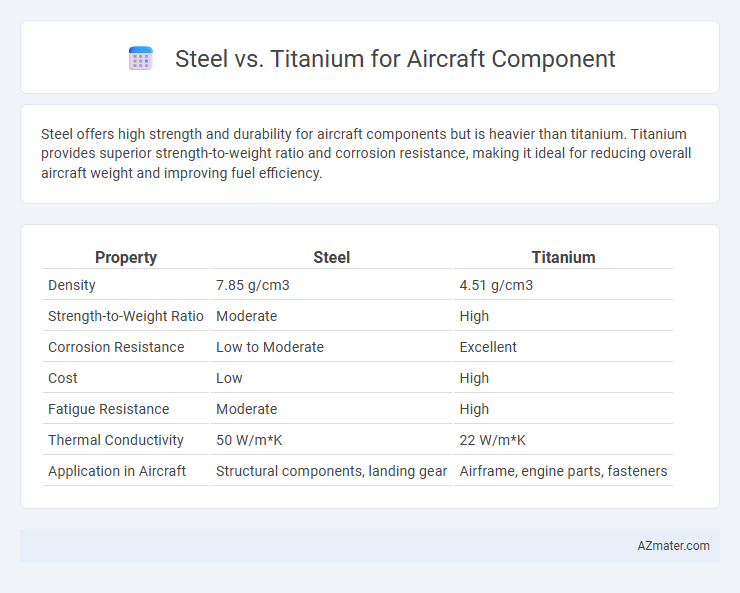Steel offers high strength and durability for aircraft components but is heavier than titanium. Titanium provides superior strength-to-weight ratio and corrosion resistance, making it ideal for reducing overall aircraft weight and improving fuel efficiency.
Table of Comparison
| Property | Steel | Titanium |
|---|---|---|
| Density | 7.85 g/cm3 | 4.51 g/cm3 |
| Strength-to-Weight Ratio | Moderate | High |
| Corrosion Resistance | Low to Moderate | Excellent |
| Cost | Low | High |
| Fatigue Resistance | Moderate | High |
| Thermal Conductivity | 50 W/m*K | 22 W/m*K |
| Application in Aircraft | Structural components, landing gear | Airframe, engine parts, fasteners |
Introduction to Steel and Titanium in Aerospace
Steel provides exceptional strength, durability, and resistance to fatigue, making it a reliable choice for aircraft structural components and landing gear. Titanium offers a superior strength-to-weight ratio, excellent corrosion resistance, and heat tolerance, which is critical for high-performance aerospace applications such as engine parts and airframe elements. Both materials play vital roles in aerospace engineering, with steel favored for its cost-effectiveness and toughness, while titanium is preferred where weight savings and high strength are paramount.
Material Properties: Strength, Weight, and Durability
Titanium offers superior strength-to-weight ratio compared to steel, making it ideal for reducing overall aircraft weight while maintaining structural integrity. Steel provides higher tensile strength and is often chosen for components requiring extreme durability and resistance to impact. The corrosion resistance of titanium significantly outperforms steel, contributing to longer service life and reduced maintenance in aerospace applications.
Corrosion Resistance: Steel vs Titanium
Titanium exhibits superior corrosion resistance compared to steel, making it highly suitable for aircraft components exposed to harsh environments and moisture. Titanium's natural oxide layer prevents oxidation and corrosion, reducing maintenance costs and extending component lifespan. Steel, although strong and cost-effective, is more prone to rust and requires protective coatings to enhance its corrosion resistance in aerospace applications.
Temperature Performance in Aviation Applications
Steel exhibits excellent temperature resistance with a melting point around 1,370degC to 1,540degC, allowing it to maintain structural integrity under high thermal stress in aircraft engines and landing gear. Titanium offers superior strength-to-weight ratio and corrosion resistance but has a lower melting point near 1,668degC, which limits its use in extreme high-temperature zones, although it performs well in moderate temperature areas like airframe components. In aviation applications, selecting steel or titanium depends on balancing temperature performance requirements with weight reduction and durability demands.
Cost and Availability of Steel and Titanium
Steel offers a lower cost and wider availability compared to titanium, making it a more economical choice for aircraft components in terms of material pricing and supply chain stability. Titanium, though significantly more expensive due to its complex extraction and processing methods, provides superior strength-to-weight ratio and corrosion resistance, which can offset higher initial costs in performance-critical applications. The global steel market benefits from large-scale production facilities and mature distribution networks, whereas titanium's limited mining sources and specialized manufacturing processes contribute to its higher cost and less consistent availability.
Manufacturing Processes and Machinability
Steel offers greater ease in machining due to its widespread availability and well-understood manufacturing processes such as forging, casting, and CNC machining, enabling cost-effective production of aircraft components. Titanium requires specialized machining techniques like slow feed rates, sharp tooling, and controlled cooling to manage its high strength-to-weight ratio and poor thermal conductivity, which increases manufacturing complexity and cost. Despite machining challenges, titanium's corrosion resistance and strength make it ideal for weight-sensitive aircraft parts, while steel remains favored for components where toughness and cost-efficiency during manufacturing are priorities.
Fatigue Resistance and Longevity
Steel exhibits excellent fatigue resistance due to its high tensile strength and ability to withstand cyclic stresses, making it suitable for critical aircraft components subject to repeated load variations. Titanium offers superior longevity in aerospace applications because of its exceptional corrosion resistance and high strength-to-weight ratio, reducing maintenance frequency and extending component lifespan. The choice between steel and titanium depends on balancing the need for fatigue durability with weight savings and environmental resilience.
Environmental Impact and Sustainability
Titanium offers superior corrosion resistance and strength-to-weight ratio compared to steel, reducing overall aircraft weight and fuel consumption, which lowers carbon emissions during flight. Steel production typically results in higher CO2 emissions and energy consumption due to its heavier weight and more intensive manufacturing processes. Recycling rates for both metals are high, but titanium's longer lifespan and reduced maintenance needs contribute to a more sustainable environmental footprint in aircraft components.
Case Studies: Steel and Titanium in Aircraft Components
Case studies reveal that titanium's high strength-to-weight ratio and corrosion resistance make it ideal for critical aircraft components such as engine parts and fasteners, significantly improving fuel efficiency and durability. Steel is favored in landing gear and structural components due to its exceptional toughness and impact resistance, providing reliability under extreme stress. Comparative analysis shows titanium reduces overall aircraft weight by up to 20%, while steel ensures cost-effective durability in high-load applications.
Conclusion: Choosing the Right Material for Aircraft Parts
Titanium offers superior strength-to-weight ratio and corrosion resistance, making it ideal for high-performance aircraft components requiring durability and low weight. Steel, while heavier, provides excellent strength and cost-effectiveness for parts subjected to high stress and impact. Selecting titanium or steel depends on balancing weight reduction, mechanical properties, and budget constraints for optimal aircraft performance and safety.

Infographic: Steel vs Titanium for Aircraft Component
 azmater.com
azmater.com